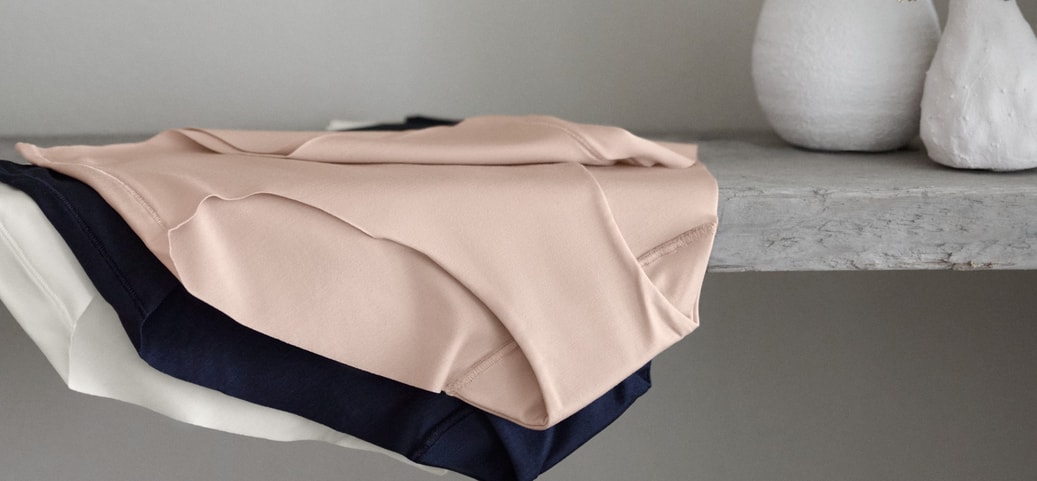Sorting laundry: How to keep clothes beautiful for a long time
Have you ever wondered why your light-coloured clothes lose their radiance after just a few washes and turn grey? Or do you have the problem that your clothes shrink, don’t get really clean or even get damaged in the washing machine? Sorting your laundry correctly is the key to keeping clothes and other textiles looking beautiful for a long time and hygienically clean at the same time. In this article, we’ll show you how to sort your laundry correctly so that it always looks fresh and clean.
by CALIDA
October 18, 2024•6 min reading time

Optimum laundry sorting saves time and effort.
Table of Contents
Sorting laundry by colour: Here’s how!
• How to wash light-coloured & white laundry correctly
• Separate coloured laundry into light & dark
• Wash dark & black laundry separately
Separate laundry by washing temperature: Pay attention to this!
• Cold wash/hand wash for particularly delicate clothing
• Delicate wash cycle at 30 °C for wool and the likes
• 40 °C for normally soiled clothes & everyday laundry
• 60 °C for germy underwear, socks and towels
• Boil wash cycle/90 °C for heavily soiled laundry & cleaning cloths
Additional options for separating laundry
Sorting laundry by colour: Here’s how!
One of the first and probably easiest steps when sorting laundry is to separate it by colour. This prevents discolouration and preserves the colours of your clothes. This is because while light-coloured and white laundry often requires more intensive cleaning, it’s important to preserve the colours of dark or colourful clothing. The colours can quickly run, especially at high temperatures and in the first wash.
How to wash light-coloured & white laundry correctly
White and light-coloured clothes tend to turn grey and dull if they are not treated properly. Make sure that you always wash these garments separately and use special detergents for white laundry. So-called heavy-duty detergents contain optical brighteners that keep your laundry bright white.
To avoid discolouration, you should never put coloured textiles in the washing machine together with white laundry. Once white or very light-coloured items of clothing have acquired a grey tinge or discolouration, it’s very difficult to get rid of them again. Special laundry whitener products can help, as can UV radiation in direct sunlight.
Separate coloured laundry into light & dark
With coloured laundry, it’s worth taking a closer look to preserve the colours for as long as possible. To do this, separate your coloured laundry into lighter colours such as pink, red, orange and yellow and darker shades like green, blue and brown. The additional separation according to colour tones or brightness prevents darker garments from transferring their colours to lighter items.
As new items of clothing made from natural materials often stain heavily, you can soak them in warm water for a night or use colour-catching cloths to further reduce the risk of staining. We also recommend using a colour detergent without bleach for all your coloured laundry. This will preserve the colours of your laundry and make them shine.
Wash dark & black laundry separately
Very dark and black clothing should always be washed separately to preserve the colour and prevent it from fading or rubbing off onto other items of clothing. Here too, there are special detergents for dark laundry that can help keeping the black longer. However, you can also use standard colour detergent for dark laundry.
Especially with dark-coloured laundry, make sure to keep the washing temperature as low as possible to prevent fading. Also turn your clothes inside out to minimise unnecessary mechanical friction on the top.

Separate laundry by washing temperature: Pay attention to this!
In addition to colour separation, the washing temperature also plays a decisive role in sorting the laundry. Different materials and degrees of soiling require different washing temperatures in order to clean the clothes effectively without damaging them.
Cold wash/hand wash for particularly delicate clothing
The cold wash programme is ideal for particularly delicate items of clothing made from silk or finely knitted wool. If your washing machine doesn’t have such a programme, you should wash these textiles in cold water with your hands.
Cold washing is gentle on the fibres and prevents the material from shrinking or warping. Depending on the material, use a mild or wool detergent and avoid vigorous rubbing and wringing to avoid stressing the fibres.
Delicate wash cycle at 30 °C for wool and the likes
Wool, cashmere and similar delicate fabrics should be washed at low temperatures, ideally at 30 °C. The delicate wash cycle has a very low number of revolutions and thus prevents the fibres from becoming matted or losing their shape. With wool, also make sure to use a special wool detergent to care for the fibres and preserve the softness of the material.
Also note that wool is a natural material with self-cleaning properties. If your garments have no stains or germs, it’s often worth hanging them out in the fresh air. Washing them too often can damage delicate textiles. Fabric softeners and the like are also an absolute taboo.
40 °C for normally soiled clothes & everyday laundry
A washing temperature of 40 °C is usually ideal for your everyday clothes and normally soiled textiles. This temperature is suitable for most cotton fabrics, but also for synthetic materials like polyester. It cleans reliably without unnecessarily stressing the fibres. As long as you pay attention to colour separation, you can usually wash different fabrics together without any problems. But more on this later.
60 °C for germy underwear, socks and towels
Underwear, socks, towels and other items of clothing or laundry that are heavily soiled and need to be hygienically cleaned should be washed at 60 °C. The temperature reliably kills most bacteria and germs and ensures thorough cleaning.
However, make sure that your textiles are suitable for this temperature to prevent shrinkage. Although bras in particular, as well as delicate pants, count as underwear, they are often more sensitive due to lace trim, padding or delicate fabrics and are not suitable for washing at 60 degrees.
Boil wash cycle/90 °C for heavily soiled laundry & cleaning cloths
Heavily soiled laundry like cleaning cloths, kitchen towels, white towels or bed linen can usually be washed at 90 °C on a boil wash cycle. This high temperature is ideal for removing stubborn stains and ensuring maximum hygiene.
However, you should also note that not all fabrics can withstand this treatment. Always check the care label before putting the laundry in the boil wash cycle. If it’s not suitable, you can pre-treat your laundry instead, e.g. by soaking it overnight in a mixture of warm water and stain remover.
Additional options for separating laundry
In addition to sorting by colour and washing temperature, there are other ways of sorting your laundry to extend the life of your clothes. While singles and couples often don’t produce enough laundry for additional separation, this type of sorting can be particularly useful for families. Clothes, sheets and towels can be easily separated in different laundry baskets, making washing quicker and easier.
Separate laundry by weight: This is the reason
Sorting laundry by weight can help to ensure an even load in the washing machine and better protect the clothes. Heavy items of clothing like jeans or towels can squash lighter fabrics like blouses or T-shirts and thus damage them.
In addition, heavy garments absorb more water, so they often require a longer or faster spin cycle than thin garments. At the same time, be careful not to put too many heavy items of clothing in the drum at once, as their weight could make the washing machine’s work more difficult.
Wash artificial and natural materials separately
If possible, you can also separate your garments by material. To a certain extent, this is already the case with delicates, as they are washed at low temperatures.
Synthetic fibres like polyester and nylon, which are washed at 30 or 40 degrees just like natural fibres, can also be washed separately. If you wash synthetic materials and natural materials like cotton or linen separately, you can prevent the textiles from affecting each other. You protect the fibres from unnecessary wear and tear.
Delicate natural materials in particular require gentle treatment, which often does not match the requirements of synthetic fabrics. A well thought out system for sorting your laundry not only saves time but also money, as you don’t have to buy new clothes as often. This is an important step towards sustainable consumption.
Discover more interesting blog posts:


